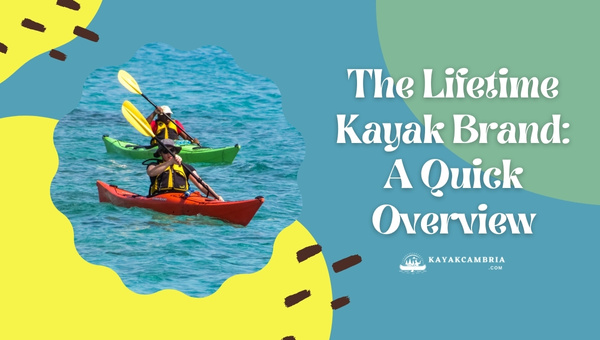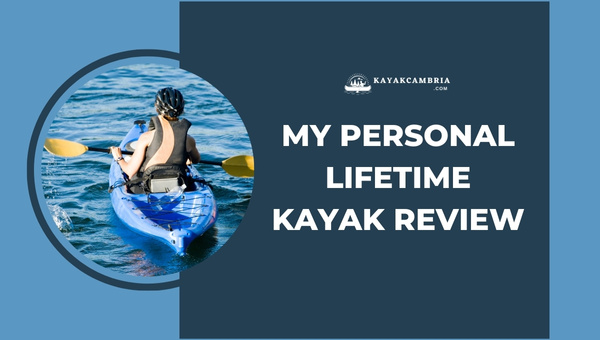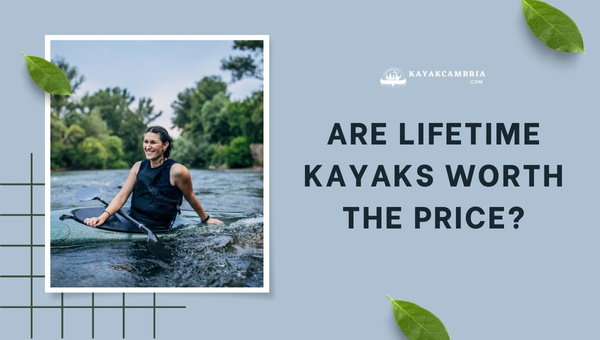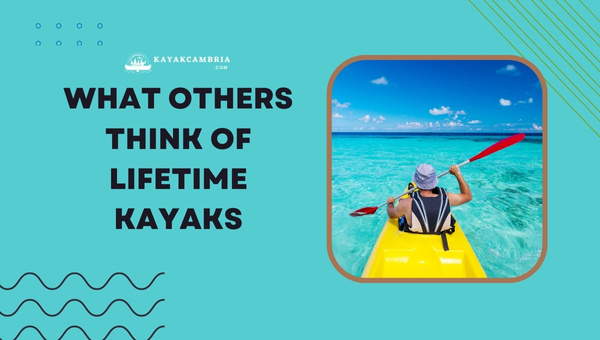As an avid outdoor enthusiast, there’s nothing I love more than exploring new adventures, especially when they involve water. So when I decided to take up kayaking as my next hobby, I knew I had my work cut out for me. With so many options available on the market, I set out on a mission to find the perfect kayak that would fulfill my needs while providing excellent value for money. After all, a kayak is not just a vessel to paddle around in; it’s an investment in countless future self-care moments and memories.
While I was eager to start gliding through the calm waters of nearby lakes and chasing adrenaline rushes down white-water rivers, I knew I had to prioritize safety, stability, and comfort to make sure I got the most out of my kayaking experience. And since there are many different types and brands of kayaks to choose from, I wanted to make the most informed decision possible.
That’s when I stumbled upon the Lifetime Kayak brand and began my deep dive into assessing whether Lifetime Kayaks were, indeed, the right choice for me. In this blog post, I will take you through my journey of discovering the world of Lifetime kayaks, discussing their features, and sharing my insights on their strengths and weaknesses. So if you are in the same boat (pun intended) as me, looking for a trusty water companion for your adventures, read on to find out if Lifetime kayaks are a good choice for you.
Contents
Contents
What Makes A Good Kayak: Key Features To Consider

When searching for the perfect kayak, there are several factors to consider, as they can significantly impact your experience on the water. In this section, I’m going to delve into some key features that make a good kayak.
1. Stability
A stable kayak is essential for both beginners and experienced kayakers. Stability is usually affected by the width (or beam) of the kayak, hull shape, and length. Wider kayaks tend to be more stable, providing better balance while on the water. Kayaks with a flatter hull design also offer more stability compared to those with round or V-shaped hulls.
2. Durability
A good kayak should last for years with proper care and maintenance. Durability is primarily determined by the materials and manufacturing process used to create the kayak. Common materials include polyethylene, high-density polyethylene (HDPE), fiberglass, and inflatable materials like PVC. When it comes to Lifetime kayaks, they are made from HDPE, which is known for its strength and longevity.
3. Comfort
When kayaking, you’ll likely spend hours on the water, so comfort is a critical factor. A good kayak should have adjustable padded seats, ergonomic cockpit design, and multiple footrest positions to accommodate users of varying heights. Added features such as thigh or knee pads can provide additional comfort during long paddling sessions.
4. Types of Kayaks
Understanding the different types of kayaks is essential when determining which one is right for you. Here’s a quick rundown of the various categories:
- Sit-On-Top Kayaks: Ideal for warm weather conditions, these kayaks allow the user to sit on top of the kayak rather than inside, making it easier to exit and enter the kayak from the water.
- Sit-In Kayaks: These kayaks provide better protection from the elements due to their enclosed cockpit, making them suitable for cold weather or rough water conditions.
- Inflatable Kayaks: Lightweight and portable, inflatable kayaks are easy to transport and store. They are great for casual paddling but may not be suitable for rough or very cold conditions.
- Fishing Kayaks: Designed explicitly for anglers, these kayaks have added features such as rod holders, gear storage, and mounting options for fish finders and GPS devices.
- Tandem Kayaks: Accommodating two or more people, tandem kayaks provide an opportunity to share the kayaking experience with friends or family members.
Keep these key features and types in mind as you continue your quest for the perfect kayak, and take the time to consider which aspects are most important for your specific needs and preferences.
The Lifetime Kayak Brand: A Quick Overview

The story of Lifetime Products Inc., the company behind Lifetime Kayaks, began back in 1986. It was founded by Barry Mower, who sought to create a durable and versatile line of recreational products, including basketball hoops, tables, chairs, and of course, kayaks. Today, the brand is headquartered in Clearfield, Utah, and has firmly placed itself among the top names in outdoor recreation products.
Being committed to innovation and bringing quality to every product they create, Lifetime Kayaks are no exception. The brand offers an extensive range of kayaks, catering to the diverse needs and preferences of kayaking enthusiasts, whether it is for beginners or experienced paddlers. With a pledge to maintain high standards of production, affordability, and customer satisfaction, Lifetime Kayaks promises to deliver an enjoyable and lasting experience for its users.
But what sets Lifetime Kayaks apart from others? Over the years, Lifetime has earned accolades for its design and the materials they use in constructing its kayaks. More specifically, their rotomolded high-density polyethylene (HDPE) construction gives their kayaks that extra edge, a factor that I will discuss in further detail later.
What’s more, Lifetime kayaks come in a variety of models, catering to the needs of different types of kayakers – from sit-inside and sit-on-top kayaks to tandem kayaks and kid versions. So, no matter your level of experience or preference, you are bound to find something from their selection that meets your needs.
If you’re in the market for a well-rounded kayak that is both durable and user-friendly, the Lifetime brand is undoubtedly worth a closer look. In the upcoming sections, I’ll delve deeper into what makes their kayaks so popular and share some insights from my personal experience with the brand. So, buckle up, and let’s find out if Lifetime kayaks are indeed good!
Assessing Lifetime Kayak Models: What Makes Them Stand Out in 2024?

As I delved deeper into the world of kayaking, I decided to take a closer look at the various Lifetime kayak models. I was eager to find out which ones stood out from the rest and why. Here are my findings:
Tamarack Angler 100
The Tamarack Angler 100 is a popular sit-on-top model designed for fishing enthusiasts. With its impressive stability, spacious seating, and multiple rod holders, it’s perfect for a relaxing day on the water. Additionally, its high-density polyethylene (HDPE) construction ensures durability while maintaining a lightweight structure.
Manta Tandem
The Manta Tandem is an excellent choice for those looking to kayak with a partner or even solo, thanks to its versatile design. This kayak has molded seats for two passengers, but it can also be converted into a single-seating configuration. It’s stability and built-in skeg make it easier to navigate calm waters, and the additional storage options make it suitable for a day’s worth of adventuring.
Lotus Sit-On-Top Kayak
The Lotus is a lightweight, entry-level kayak designed for beginners and occasional paddlers. Its compact size and easy maneuverability make it a popular choice for those looking to get started in kayaking without a hefty price tag. The kayak’s construction from UV-protected HDPE ensures its durability and resistance to fading, even with extended exposure to sunlight.
Emotion Spitfire
If you’re looking for speed and agility, the Emotion Spitfire kayak might be just what you need. This sit-on-top model boasts a sleek design that cuts through the water effortlessly, allowing you to cover more distance in less time. Its self-bailing scupper holes also help to keep the cockpit dry, improving your overall paddling experience.
After assessing these models and their unique features, it became clear to me that Lifetime kayaks are known for their stability, durability, and user-friendly designs. Their HDPE construction and innovative features truly set them apart from other kayak options available on the market, making them a strong contender for someone considering a new kayak purchase.
Lifetime Kayak Material: High-Density Polyethylene (HDPE)

When it comes to deciding whether Lifetime kayaks are good or not, it is essential to look into the key material used in their construction. Lifetime kayaks are primarily made from high-density polyethylene (HDPE), a type of plastic known for its strength, durability, and flexibility. There are several advantages to using HDPE for kayaks:
Advantages of HDPE Material
- Durability: HDPE is an extremely strong material that’s resistant to cracks, chips, and dents. This means your Lifetime kayak can withstand rough conditions and impact better than many other types of kayaks, ultimately increasing its lifespan.
- Lightweight: Despite its strength, HDPE is a relatively lightweight material. This makes Lifetime kayaks easier to transport, handle, and maneuver on the water, making them more enjoyable to use, especially for beginners.
- UV resistance: Exposure to the sun’s rays can be harmful to many materials; however, HDPE is UV-resistant, ensuring that your kayak will not fade or become brittle over time. This is an important factor to consider, as it contributes to the overall longevity of your kayak.
- Low-maintenance: HDPE is a low-maintenance material that requires very little care. Since it doesn’t absorb water or promote mildew growth, you can simply rinse your kayak off after use, and you’re good to go.
- Environmentally friendly: HDPE is recyclable, meaning that it can be turned into new products at the end of its life cycle. By choosing a kayak made from HDPE, you’re contributing to a more sustainable future in the process.
Comparing HDPE to Other Kayak Materials
While HDPE is quite popular for kayak construction, there are also other popular materials in the market, such as fiberglass, composite materials, and inflatable options. It is important to understand where HDPE kayaks stand when compared to these alternatives.
- Fiberglass kayaks are generally more expensive and heavier than HDPE models. They also require more maintenance, as they may develop gel coat cracks and can be damaged by prolonged UV exposure.
- Composite kayaks (made from carbon fiber or Kevlar) tend to be lighter and offer better performance, but they are also considerably more expensive and may not be as durable as HDPE kayaks.
- Inflatable kayaks are typically the most affordable and lightweight option, but they generally do not perform as well as HDPE or other rigid options, and their durability is relatively less.
Taking these comparisons into consideration, it’s clear that HDPE, as used in Lifetime kayaks, is an excellent choice for many kayaking enthusiasts looking for a durable, lightweight, and low-maintenance option.
Real-Life Experience: My Personal Lifetime Kayak Review

As a kayaking enthusiast, I decided to give Lifetime Kayaks a try and share my personal experience. Being a meticulous person, I did extensive research before purchasing a Lifetime Tamarack 100 sit-on-top kayak. Here’s a detailed breakdown of my experience with this particular model.
Comfort and Stability
Lifetime Tamarack 100 impressed me with its comfort and stability. Unlike many other kayaks I have tried, the molded seat was comfortable for extended periods of time. I sat for hours exploring nearby lakes without feeling any discomfort. The kayak’s stability is undeniably exceptional as well as I paddled through calm or rough waters without feeling wobbly.
Tracking and Maneuverability
Another aspect worth mentioning is the kayak’s tracking. I find it amazing how well this kayak holds a straight line while paddling. The included skeg increased tracking performance even further. Maneuverability is also pretty good in small waterways as well.
Storage and Maintenance
When it comes to storage, the Lifetime Tamarack 100 offers front and rear storage compartments sealed with bungee cords. These compartments proved to be sufficient for my day trips, easily accommodating my gear, drinks, and snacks. Additionally, I love how low-maintenance this kayak is. Its material, High-Density Polyethylene (HDPE), does a remarkable job of preventing scratches and other damages. Cleaning was easy, as I just needed to rinse it with fresh water and let it air dry.
Portability
While the Lifetime Tamarack 100 is not the lightest kayak on the market weighing around 50 pounds, I managed to load and unload it to my car’s roof rack without much struggle. The kayak features front and rear T-handled grips, which made transport a breeze.
Overall, I am thrilled with my purchase of the Lifetime Tamarack 100 kayak. It delivered an excellent combination of comfort, stability, tracking, maneuverability, and storage. The durable HDPE material ensures low maintenance, making it a fantastic investment for those who want a reliable kayak without breaking the bank.
Affordability: Are Lifetime Kayaks Worth The Price in 2024?

When it comes to investing in a kayak, it’s important to consider not only the quality and performance of the vessel but also its affordability. In this section, I’ll dive deeper into the price range of Lifetime kayaks and compare them to other brands in terms of value and investment.
Price Range
Lifetime kayaks have a wide range of prices, starting from around $250 for their entry-level models up to $800 or more for the higher-end options. This price range is quite competitive when compared to other kayak brands in the market.
While there are certainly cheaper kayaks available, it is important to assess the overall value and quality that the brand offers. Mere affordability is not to be mistaken for a good buy.
Value for Money
Lifetime kayaks strike a great balance between quality and affordability. Their kayaks are made from high-density polyethylene (HDPE), which makes them durable, lightweight, and resistant to UV damage. This material choice ensures that you can enjoy worry-free kayaking and that the lifespan of your kayak is extended.
Additionally, Lifetime kayaks are equipped with a variety of useful features that increase their value for money, such as comfortable seating options, ample storage, and built-in carry handles.
In comparison to other popular brands, such as Perception, Wilderness Systems, and Ocean Kayak, Lifetime kayaks still manage to offer a competitive edge in terms of affordability while not compromising on essential features.
Investing in a Lifetime Kayak: Is it Worth it?
When analyzing the affordability of Lifetime kayaks, it’s essential to look at the long-term benefits they provide. These kayaks are designed to be resilient against wear and tear from the elements. Their UV protection ensures that their color and structure won’t easily degrade over time.
Furthermore, Lifetime kayaks come with a manufacturer’s warranty, giving you peace of mind in case of any defects. This shows the brand’s confidence in the quality of its products.
Considering the overall quality, features, and materials used in manufacturing Lifetime kayaks, I believe that they indeed offer excellent value for their price range. If you’re in the market for a reliable and affordable kayak, Lifetime kayaks are a strong contender worth considering.
Community Feedback: What Others Think of Lifetime Kayaks?

Diving into the realm of Lifetime kayaks inevitably led me to seek the opinions of fellow kayakers who have already put these vessels to the test. By turning to online forums, reviewing websites, and even talking to some kayak enthusiasts at my local paddling spot, I was able to gather a wealth of community feedback. Here’s a summary of the general consensus, along with some common praises and complaints.
Pros of Lifetime Kayaks
- Stability: Many Lifetime Kayak users appreciate their stability, especially beginners who are getting acquainted with the sport. This feature seems to instill confidence and helps riders build their kayaking skills over time.
- Durability: High-Density Polyethylene (HDPE) is a favorite among kayakers for its resilience. This material makes Lifetime kayaks durable, and they can withstand the wear and tear that comes with frequent use.
- Ease of Transport: Lifetime kayaks are lightweight without compromising their structural integrity. This quality makes transporting and maneuvering these kayaks on land much more manageable.
- Value for Money: Many kayakers feel Lifetime offers great value for the money, particularly when comparing the kayaks to higher-end models. They strike a balance between quality construction and affordability.
Cons of Lifetime Kayaks
- Limited Features: Some experienced kayakers find that Lifetime kayaks lack advanced features and customization elements. Professionals, particularly those who are into adventurous activities such as whitewater kayaking or sea touring, might want to consider other specialized kayak brands.
- Slower Speed: In terms of performance, it’s essential to know that many Lifetime kayak models aren’t built for speed. While this won’t affect every user’s experience, those looking for a fast-paced ride might be disappointed.
- Seat Comfort: Although Lifetime kayaks have adjustable seats, some users still report discomfort after extended periods of usage. However, this comfort level varies from one person to another, and additional padding options are available to alleviate this issue.
My analysis of community feedback on Lifetime kayaks reveals that they are generally considered reliable, user-friendly, and a good value. While they may not cater to all kayaking enthusiasts’ preferences or needs, they are an excellent choice for many individuals who are new to the sport or enjoy recreational paddling.
Making an Informed Decision: Are Lifetime Kayaks the Right Choice for You?

When it comes to deciding whether Lifetime kayaks are the right choice for you, it’s essential to consider your personal needs, preferences, and kayaking goals. Each person’s kayaking journey is unique, and what works for one person may not be the best fit for another. In this section, I will walk you through the key factors to keep in mind when evaluating if a Lifetime kayak is the ideal choice for you.
Consider Your Preferred Kayaking Activities
Think about the activities you plan to enjoy with your kayak. Are you into recreational kayaking in calm waters, or do you prefer whitewater adventures? Lifetime kayaks are generally best suited for recreational and fishing activities, making them a good option for beginner and intermediate paddlers. If you’re a more advanced kayaker or seeking high-performance options for specific kayaking disciplines, you may need to explore other brands.
Assess Your Budget and Value for Money
Lifetime kayaks are known for their affordability. When comparing their costs to other kayak brands, Lifetime offers a competitive pricing range for their products. It’s essential, however, to bear in mind that you should not compromise on safety, performance, and durability for the sake of saving money. Consider the long-term value of the kayak, and take into account any accessories and equipment that you’ll need to invest in as well.
Assess the Kayak’s Weight and Portability
Consider the weight and portability of the kayak you’re interested in. Lifetime kayaks are typically lightweight and easy to transport, making them a great choice for those who value convenience. Think about how often you plan on moving and storing your kayak, and whether a heavier, bulkier option would hinder your enjoyment of the sport.
Think About Your Skill Level and Room for Growth
It’s important to choose a kayak that fits your current skill level and still offers room for growth as you progress in the sport. Lifetime kayaks often cater to beginner and intermediate paddlers, with user-friendly features and moderate performance capabilities. If you foresee yourself advancing rapidly in skill or becoming involved in more specialized kayaking activities, you may want to consider kayaks with higher performance and versatility.
Frequently Asked Questions
1. How do Lifetime Kayaks compare to other leading kayak brands?
Lifetime Kayaks have gained a reputation for their durability, stability, and affordability when compared to other leading brands. However, personal preferences, intended use, and required features will differ between individuals, so it’s essential to research all available options before making a decision.
2. What type of activities are Lifetime Kayaks best suited for?
Lifetime Kayaks are versatile and suitable for various activities such as recreational kayaking, fishing, and even some tandem paddling experiences. With multiple models catering to different skill levels, you can find a Lifetime Kayak suited to your specific needs.
3. Are Lifetime Kayaks suitable for beginners?
Yes, Lifetime Kayaks are a great option for beginners due to their stable and durable designs, along with features accommodating various skill levels. However, as with any kayak brand, it’s essential to choose the right model based on your needs and experience level.
4. Can Lifetime Kayaks be used in different water conditions?
Lifetime Kayaks are designed for various water environments, such as calm lakes, slow-moving rivers, and ocean bays. However, they may not perform well in extreme conditions such as whitewater rapids or open ocean. It’s crucial to know your kayak’s limits and stay within safe and suitable water environments.
5. How do I care for and maintain my Lifetime Kayak?
Proper care and maintenance can significantly extend the lifespan of your Lifetime Kayak. This includes rinsing the kayak and its components with fresh water after each use, regularly checking and tightening any hardware, and properly storing it in a sheltered, cool, and dry area when not in use.
6. What type of warranty does Lifetime offer on their kayaks?
Lifetime offers limited warranties on their kayaks, with most models covered for up to 5 years. This warranty covers material defects and workmanship, ensuring your investment is protected. For complete details and specifics, refer to the warranty information provided with your kayak or contact Lifetime directly.
Conclusion
Lifetime kayaks have proven to be an excellent choice for many kayaking enthusiasts, myself included. They are known for their durability, thanks to the high-density polyethylene (HDPE) material used in their construction, which ensures they can withstand the test of time and the elements. The various Lifetime kayak models cater to different skill levels and preferences, making it likely that you’ll find a kayak that suits your needs.
Affordability is another key factor that makes Lifetime Kayaks stand out among its competitors. Their reasonable prices, coupled with good quality and performance, provide great value for the investment. This makes them an attractive option, especially for those who are just entering the world of kayaking.
However, it’s crucial to remember that no single kayak brand can cater to everyone’s preferences and needs. While I’ve had a great experience with my Lifetime kayak, and numerous others within the kayaking community seem to share this sentiment, it’s essential to conduct your own research and read user reviews before making a decision.
So, are Lifetime kayaks good? Based on my personal experience and meticulous research, I believe they are. Still, it’s important to consider your unique requirements and preferences and explore other options before making a final decision. Happy kayaking!

